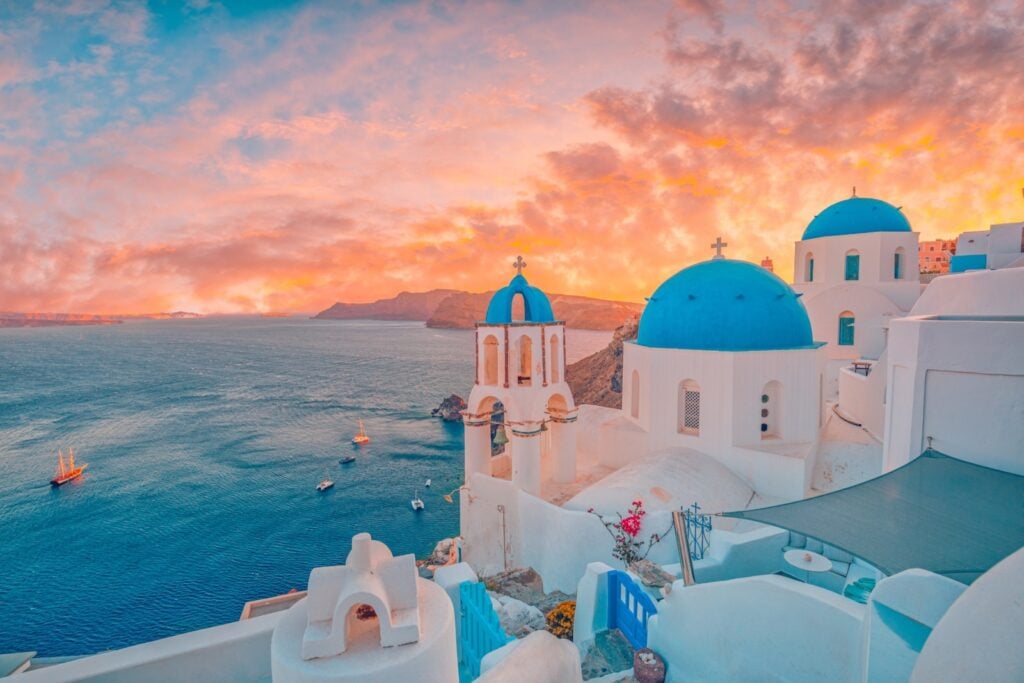Quick search
CTRL+K
Quick search
CTRL+K
Santorini, famed for its dramatic cliffs, whitewashed houses, and sapphire-colored Aegean Sea, this volcanic island transforms into a spectacle of faith and festivity come during the Orthodox Easter. This year, Orthodox Easter graces Santorini with its reverent and joyous festivities on May 5th, adding an extra layer of significance to an already enchanting destination. As the island’s vibrant bougainvillea blooms and the scent of citrus perfumes the air, locals and visitors alike eagerly await the dawn of this sacred season, a time when Santorini’s cultural heritage shines brightest.

Officially known as Thera, is a captivating island nestled in the Aegean Sea, renowned for its breathtaking vistas, stunning sunsets, and rich history. The island’s geological formation is the result of a cataclysmic volcanic eruption around 3,600 years ago, one of the most powerful in recorded history. This eruption reshaped the landscape, forming the iconic caldera that defines Santorini’s unique topography. Throughout the centuries, Santorini has been inhabited by various civilizations, including the Minoans, Phoenicians, Dorians, and Byzantines, each leaving their mark on the island’s culture and architecture.
In antiquity, Santorini was known as Strongyli (Round) due to its circular shape, later renamed Thira after the Spartan hero “Theras” who colonized the island in the 9th century BCE. The island flourished during the Minoan period, with the ancient city of Akrotiri serving as a major trading hub until it was buried beneath volcanic ash during the eruption around 1,600 BCE. In the centuries that followed, Santorini experienced successive waves of conquest and settlement, contributing to its diverse cultural heritage. Today, Santorini’s rich history, coupled with its unparalleled beauty, continues to attract visitors from around the world, making it a timeless destination steeped in both myth and reality.
Travelling to Santorini is convenient, with its Santorini Airport (JTR) being connected to Athens, Thessaloniki and twenty major European countries. The island is also connected to the Greek mainland by boat, as well as many nearby islands.Visitors can choose from various transportation options, ensuring a smooth journey.
Santorini is easily accessible from the United Kingdom. Direct flights operate from London, Bermingham and Manchester, according to Skyscanner. The flight usually takes up to four hours.
For those seeking a more scenic route, ferries from Piraeus Port in Athens are available. The ferry journey provides an opportunity to enjoy the Aegean Sea and approach Santorini by sea, revelling in the anticipation of its iconic views. Check Ferryscanner for tickets.

During Easter, Santorini experiences the beginnings of springtime, characterised by mild temperatures and increasing sunshine. In April, the average daytime temperatures range from around 15 to 20 degrees Celsius, although temperatures can vary slightly depending on the specific day and elevation.
While the weather during Easter in Santorini generally tends to be pleasant and mild, it’s important to note that evenings and nights can still be cool, so it’s advisable to pack layers or a light jacket for outdoor activities or evening strolls. Additionally, Santorini’s weather can be somewhat unpredictable during this transitional season, so it’s always a good idea to check the forecast closer to your travel dates for the most accurate information.
You can check weather conditions for Santorini on meteo.gr
Santorini beckons with its iconic white-washed buildings, stunning sunsets, and crystal-clear waters. Some of its top destinations include the charming villages of Oia and Fira, the ancient site of Akrotiri, and the unique Red Beach.












In Santorini, Orthodox churches stand as timeless symbols of faith and tradition, adorned with iconic blue domes and whitewashed walls against the backdrop of the azure Aegean Sea. Each church embodies the island’s spiritual essence and architectural splendor, inviting visitors to immerse themselves in the beauty and tranquility of Greek Orthodox heritage.






During Orthodox Easter , the island comes alive with unique church services that blend ancient traditions with modern celebrations.
During Holy Thursday, special morning service, the Vesperal Divine Liturgy of Saint Basil, takes place. This liturgy remembers the Last Supper, where Jesus established the sacrament of the Eucharist. In the evening, the reading of the Twelve Gospels is a unique element on Thursday night. These twelve passages recount the events leading up to Christ’s crucifixion, preparing the faithful for the somber mood of Holy Friday.

Holy Friday is a day of mourning. Α solemn ceremony called the Veneration of the Cross takes place. During this ceremony, the faithful venerate the cross, a symbol of Christ’s sacrifice. Another unique element of Holy Friday is the Epitaphios, a beautiful floral decoration symbolising the tomb of Christ. The Epitaphios is adorned with flowers and icons, and is paraded through the streets during the night while the faithful are chanting mourning chants.

One of the most significant moments of the Easter period is the midnight liturgy on Holy Saturday, where worshippers gather to celebrate the Resurrection with candlelight processions, hymns, and the symbolic lighting of the Holy Fire from Jerusalem. The bells rang while the faithful chant Hristos Anesti! (Christ is Risen) accompanied by fireworks.

On every sacred Friday evening, as twilight descends upon the village of Pyrgos, a profound transformation takes place. The cobblestone streets, once quiet and unassuming, are now ablaze with the radiant glow of thousands of tin lanterns, known as “Tenekedakia,” adorning every corner and alley, as if stars had descended from the heavens to dance among mortals.
This enchanting display creates a mesmerising river of fire, each flickering flame casting its ethereal glow upon the ancient walls and weathered paths. The air is alive with anticipation, as the village awakens with the fervour of tradition and reverence.
As the procession of the Epitaphios commences, the atmosphere becomes palpably solemn, imbued with a sense of sacred purpose and contemplation. This venerable custom, spanning fifty years of history, draws pilgrims and travelers from near and far, each year witnessing its magnificence with awe and reverence, ensuring that its legacy endures for generations to come.

Dining experiences during Easter range from intimate family gatherings in local tavernas to grand feasts in upscale restaurants, all celebrating the spirit of the season with culinary delights that reflect the island’s rich culinary heritage and warm hospitality.
Here are the best Easter dishes, steeped in tradition and bursting with flavour:
 Magiritsa Soup: A savory delicacy crafted from lamb offal, rice, and aromatic herbs like dill and parsley. Traditionally enjoyed after the midnight Resurrection service, it symbolizes the breaking of the fast following Lent.
Magiritsa Soup: A savory delicacy crafted from lamb offal, rice, and aromatic herbs like dill and parsley. Traditionally enjoyed after the midnight Resurrection service, it symbolizes the breaking of the fast following Lent.




A special mention to these local dishes of Santorini!:




Don’t forget to check our special guide about Greek cuisine!

Find more top restaurants in Santorini on Tripadvisor!
During Easter, Santorini offers a range of accommodation options, from luxurious cliffside hotels with panoramic views of the caldera to charming boutique guesthouses in traditional villages. Visitors can indulge in the island’s renowned hospitality while enjoying special Easter packages that may include festive meals, cultural experiences, and relaxation amenities.
Find more Greeklist exclusive Hotel deals for Santorini and HotelBrain here!
Here are five islands near Santorini that are worth exploring that provide diverse experiences and are easily accessible from Santorini, making them perfect destinations for day trips or longer excursions





These islands provide diverse experiences and are easily accessible from Santorini, making them perfect destinations for day trips or longer excursions.
Navigating Santorini’s enchanting landscapes is made easy with a variety of transportation options catering to every traveler’s preferences and offering seamless access to the island’s treasures.

Prepare for your Santorini adventure with these essential safety and travel tips, ensuring a smooth and memorable experience amidst the island’s breathtaking landscapes and rich cultural tapestry.
What caused the formation of Santorini’s unique caldera?
Santorini’s caldera was formed by a massive volcanic eruption around 3,600 years ago, one of the most powerful in recorded history, which shaped the island’s distinctive landscape.
How many islands make up the Santorini archipelago?
Santorini is actually a complex of islands, including Thira (Santorini), Thirassia, Nea Kameni (the volcano), and Palea Kameni, all formed by volcanic activity over thousands of years.
What are some architectural features typical of traditional Santorini buildings?
Traditional Santorini architecture features whitewashed buildings with blue-domed roofs, narrow winding streets, and cave houses carved into the volcanic cliffs, creating a stunning and unique aesthetic.
What does the name Santorini mean?
The name ‘Santorini’ is a contraction of the words “Santa” and “Irene” from the name of the old cathedral in the village of Perissa
How difficult is the walk from Fira to Oia?
Generally considered a moderately challenging route, it takes an average of 3 h 13 min to complete. This is a very popular area for hiking, so you’ll likely encounter other people while exploring.
What are some unique souvenirs to buy in Santorini?
Santorini offers a variety of unique souvenirs, including handmade ceramics, local artwork, traditional Greek sandals, olive oil products, and locally produced wines.
What is Santorini nightlife like?
Santorini offers a wide variety of nightlife spots, ranging from cocktail or champagne bars to beach clubs.
Is the Santorini volcano active?
Even though it is currently dormant, the Volcano of Santorini is active and a fascinating sight to visit!
Is sunset in Oia worth it?
It is a rewarding experience and a magical sight that will surely come to your mind every time you think of your holidays in Santorini!
Can be Santorini the lost Atlantis?
Many scholars believe that Santorini could be the legendary continent that plunged to the bottom of the sea after a terrible earthquake. The Greek philosopher Plato’s dialogues include numerous references suggesting that this claim might be true.
What is the ghost village of Santorini?
The village of Mesa Gonia, which was completely destroyed during the great earthquake of 1956 and therefore also called “Ghost Village.”
What makes Santorini so popular?
Santorini Island is famous for its breathtaking sunset views and for a good reason. The island’s whitewashed buildings perched on the cliffside, with their blue domes, are iconic of Santorini
How is Orthodox Easter celebrated in Santorini?
Orthodox Easter in Santorini is celebrated with religious fervor and festive traditions. Locals attend church services throughout Holy Week, culminating in the midnight Resurrection service on Holy Saturday and Easter Sunday festivities.
What is the significance of the “Anastasi” (Resurrection) service on Holy Saturday?
The “Anastasi” service marks the moment of Christ’s Resurrection and is a central event of Orthodox Easter. In Santorini, locals gather at churches, lighting candles and exchanging greetings of “Christos Anesti” (Christ is Risen) to celebrate the triumph of life over death.

As Easter approaches on the enchanting island of Santorini, the air is filled with a sense of renewal and celebration. From savoring traditional delicacies to embarking on scenic adventures, this time of year offers a unique opportunity to immerse oneself in the rich cultural heritage and natural beauty of the Cyclades.
Whether enjoying festive feasts with loved ones, exploring historic churches, or simply basking in the warmth of the Mediterranean sun, Santorini beckons travelers to embrace the spirit of Easter and create unforgettable memories against the backdrop of its timeless landscapes. As the island awakens to the promise of spring, may your Easter on Santorini be filled with joy, peace, and the magic of new beginnings.

You can also experience the Orthodox Easter 2024 in Rhodes, Syros and Corfu!
Check also our Summer travel guides to Athens, Thessaloniki, Crete, Nafpaktos, Ioannina and Mykonos!

Evangelos Kasapakis


Evangelos Kasapakis

No results available
Greek List 2025 © All rights reserved. Created by CoDicts